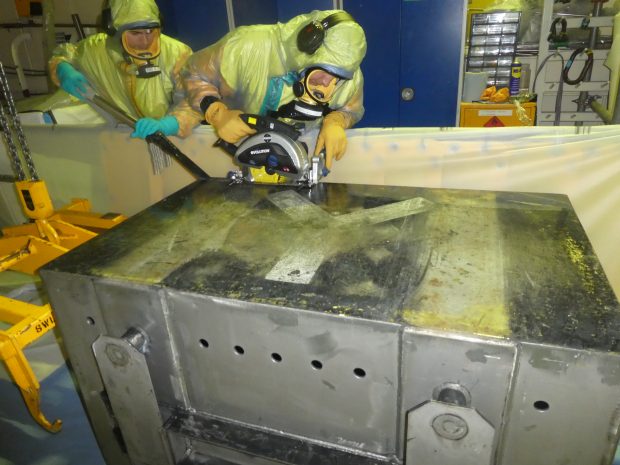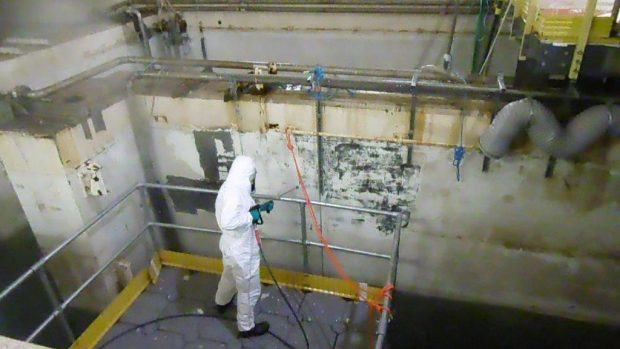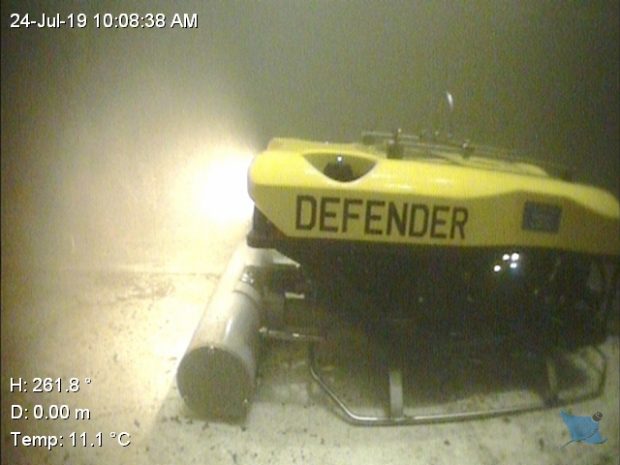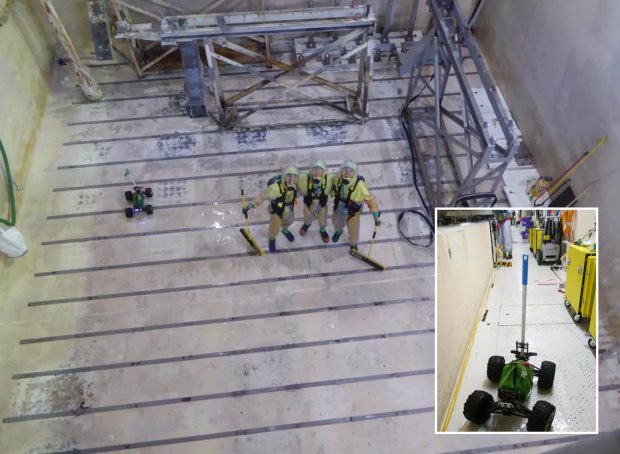
Learning shared across the fleet
All Magnox spent fuel ponds are, like the sites themselves, completely different. Some have two ponds, some just one, some are fairly clean while others are cluttered and highly contaminated. Wylfa, meanwhile, has dry stores instead of ponds.
Although this means the clean-up process is a far cry from ‘one size fits all’, the common understanding and toolkits developed through the Magnox ponds programme have helped to build a bank of knowledge for sharing across the fleet.
Most recently, Dungeness A, Oldbury and Sizewell A have all completed comprehensive programmes to drain and clean their ponds deploying a variety of techniques that range from the original and innovative to the conventional.
Each programme, running over approximately three years, cost more than £20 million. Together, their achievements represent a key milestone for the NDA group’s corporate targets. .
Across the 10 Magnox reactor sites, the whole ponds clean-up programme is anticipated to cost around £300 million. Simple innovative processes and shared learning have reduced the earlier original estimate by £45 million.
Water now remains only in the Chapelcross ponds, and the site is set to reap the benefit from the learning and hands-on experience at other sites.
Milestone at 3 sites
Teams of commercial diving specialists from the US were deployed at Dungeness and Sizewell to cut up and retrieve underwater items, but Oldbury’s relatively clean ponds were emptied using more standard methods.
Divers were first used in the UK nuclear industry at Winfrith during the 1990s, to cut up steelwork eight metres below the surface of the Steam Generating Heavy Water Reactor’s pond.
Magnox Chief Executive Gwen Parry-Jones said:
Achieving this tremendous milestone at three sites is the culmination of many years preparatory work and demonstrates the value of collaboration across the Magnox fleet, which has accumulated valuable knowledge and expertise through the Ponds Programme. The teams involved have shown real commitment and innovation to overcome all the challenges.
Dungeness
Divers from the US first dipped their toe into Magnox ponds at Dungeness in 2016, cutting up equipment, including skips, and retrieving manageable-sized items from the floor of both ponds.
With water acting as a radiation shield, the divers were able to work close to the empty skips and other equipment, and gain access to awkward areas.
When operational, Dungeness’s two ponds, each with five bays, held 2,000 cubic metres of water, which has now been drained out and filtered through the single treatment plant that handles all active site water. After the divers had completed their work, a mechanical long-reach grab retrieved remaining items while residual sludge was removed by an industrial-sized wet vacuum cleaner known as the ‘Big Brute’, and pumped into shielded tanks ahead of retrieval and treatment through the Advanced Vacuum Drying System (AVDS). AVDS dries out the waste, leaving a smaller and more stable volume for storage.

Programme Delivery Manager Tony Wells added:
It’s difficult to know exactly what’s in the ponds because the equipment agitates the water, limiting visibility. There was, in fact more sludge and debris than we anticipated. We also decided to use long-reach manual tools rather than Remotely Operated Vehicles (ROVs) as the team already had experience in this technique from Hinkley A and Bradwell, so were familiar with the radiological conditions, and could build on previous learning.
Walls and floors were cleaned and stabilised using high-pressure water jets, and radiological surveys completed. With the target milestone achieved, the next step is to decontaminate the large steel splitter flask used to transfer fuel lugs to lug vaults for storage, before being put through a dissolution process.
Finally, all ancillary equipment such as pipework and pumps, will need to be removed before the ponds are ready to hand over to the plant and structures team for eventual demolition.
Sizewell
Sizewell’s single pond, with five bays, contained 3,300 cubic metres of water. When the divers left Dungeness, this is where they came, bringing all the learning. Over around 10 months, they cut up 35 skips, approx 70 tonnes of ponds equipment, collected miscellaneous contaminated and activated items and pumped most of the sludge, approx. 4 cubic metres, to a holding tank.
A conventional hoist removed size-reduced pond equipment, which was packaged and handed to the waste operations team.
A small remotely operated submersible vehicle (ROV), acquired second-hand from Bradwell, assisted with inspecting the pond structure and equipment, helping the team understand what was needed for decommissioning. In-house repairs to the ROV led to a focus on maximising its capabilities, and a newer model was purchased, with grab and manipulator tools to retrieve residual lightweight items, reaching into difficult-to-access tunnels and bays.

The ROV, a VideoRay Pro 4, was replaced with the more powerful the new-to-the-market Defender, which could lift up to 25kg. The team began experimenting with interchangeable sludge removal tools, which were designed and manufactured in-house before testing in a local dive pool.
Project Engineer Nick Joy said.
We were conscious that once in the water, it had to be just right. We bought a collapsible pool, filled it with sand and sludge to continuing testing. We linked it to a pumping system, and it worked like a dream.
Ponds Programme Delivery Manager Steve Franks added:
The achievement is a tribute to the team’s innovative approach and determination to succeed.
Remaining sludge was pumped into a storage tank and will be retrieved, dried out in ductile cast-iron containers (DCICs) for transfer to Bradwell’s Intermediate Storage Facility.
Nick added:
These were new on the market and we’ve customised them to retrieve sludge and debris from spent fuel ponds. They’re now ready to use elsewhere, including Sellafield, Chapelcross or further afield … anywhere really!
With all pond bays drained, work is under way to decontaminate and stabilise walls and floors.
Oldbury
The pond at Oldbury, one of the newest Magnox sites, is smaller than Sizewell, containing 2,500 cubic metres of water – but still the size of an Olympic swimming pool – and has benefitted from the operational experience of the older stations, with pond conditions well controlled during its generating life.
Since 2016, a variety of wastes have been removed and disposed of. Along with 40 tonnes of redundant equipment, the project also processed highly contaminated IONSIV cartridges and filters from Dungeness and Sizewell that had previously been consolidated with those at Oldbury. The items were remotely packaged into self-shielded MOSAIK containers. By working closely with the central waste team, the number of MOSAIKs required was reduced from 24 to 10.
As divers prove to be of most value for large retrieval / size-reduction campaigns involving equipment attached to pond floors, Oldbury opted to size-reduce skips in air using bespoke steel shielding designed by the in-house ponds team and manufactured locally. The shielding protected workers as they cut up skips, while a ventilation system extracted airborne contamination.

Slots in the shielding allowed a saw to fit through and cut the skip underneath, with a bracing mechanism preventing the sides from collapsing when the shielding was removed.
Ponds Programme Delivery Manager Mark Liston explained:
Our methods were simple and many tools we deployed had been developed and used on the Hinkley ponds, and were suitable for Oldbury.
One of the successes from Hinkley’s innovative work included using a miniature electric car, available for a few hundred pounds, that was fitted with a remote dose monitoring system to check conditions on the drained pond floor before people were allowed in.
The pond basin is now being decontaminated by pressure washing and being surveyed to ascertain residual radiological conditions.
Recent Comments